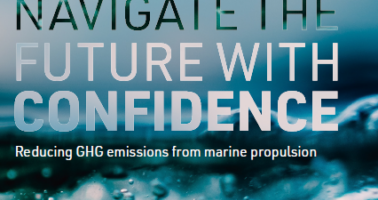November 9, 2021
The Swiss company WinGD, developer of marine engine technology, has published a new white paper in which it sets out the steps that, in its opinion, will allow deep-sea navigation to be decarbonized in accordance with IMO provisions. The guide is intended to enlighten shipowners about options that can be taken with confidence today to drastically reduce emissions, rather than waiting for the emergence of "miracle" technologies.
The document, titled "Navigate the Future with Confidence", advocates a holistic and gradual approach to improving energy efficiency. The use of LNG is one of the biggest ways to reduce emissions in today's ships and will allow the use of synthetic gas or carbon-neutral biogas when available.
Taking into account typical fleet turnover times, the expected reduction in GHG emissions from international shipping can only be achieved through massive decarbonisation; that is, the early and massive adoption of carbon neutral fuels, whether they are biofuels produced in a sustainable way or synthetic fuels produced using excess renewable energy and a suitable raw material. No fuel alone will do. On the contrary, it will be necessary to take advantage of all sustainable sources and we will see a wide variety of fuels, both gaseous and liquid, enter the marine fuel market.

Acting now is the right choice, as it will not be enough to wait for clean fuels to become available. Other technologies also need to be added to help ships meet the IMO 2050 target.
"The low-speed marine engine will continue to be the main energy provider for deep-sea navigation. The heart of clean propulsion is already underway and the task now is to incorporate the technologies that will help achieve zero emissions: carbon-neutral fuels , hybrid electric power sources, digital technologies that improve efficiency and optimized ship design."
Dominik Schneiter, Vice President of Research and Development at WinGD
X-DF2.0
The white paper highlights engine developments that enable the use of clean fuels such as ammonia and methanol by 2025, in particular WinGD's X-DF dual-fuel engine platform and the recent launch of X-DF2.0 technologies. , which can cut methane slippage in half and greenhouse gas emissions by one more 10%.
The second generation of X-DF engine technologies, introduced in 2020, further improves greenhouse gas performance. The main component of the X-DF2.0 is the intelligent control through exhaust gas recycling (iCER), which allows to increase the percentage of inert gas in the combustion chamber, thereby achieving greater control of combustion .
The result is a reduction in methane slip emissions of up to 50% when using LNG and a significant reduction in fuel consumption from 3% in gas mode and 5% in diesel mode. The combined effect of using less gas fuel and reducing methane slip is an improvement in global GHG emissions of nearly 10% in gas mode compared to first-generation X-DF engines.
In addition, the engine offers greater emission reduction potential by allowing operators to mix fossil or renewable LNG with hydrogen.

WinGD's development work on hybrid power systems is also summarized. The company has developed a complete simulation platform to study hybridization options for all applications and operating models. Combinations of two-stroke engines and batteries, connected by power take-off systems, are studied in the white paper in order to reduce installed power, fuel consumption and emissions, thus clearly improving the EEDI / EEXI classifications. and eventually also CII.
"By preparing for these future scenarios, WinGD is de-risking engine investments for shipowners and operators," said Dominik Schneiter. "In uncertain times, our extensive research aims to put the future performance and compliance of WinGD engines beyond doubt."

